
QUT's spectacular digital display space The Cube is helping industry, government and not-for-profits build better digital products for the public.
At two storeys tall and incorporating 48 touch screens, The Cube is the world's largest digital interactive installation.
It was designed, prototyped, developed and built by QUT staff, whose expertise is now being sought for a range of business, research and philanthropic collaborations.
Collaborators include Microsoft Research and its WorldWide Telescope (WWT), a web portal that brings together imagery from the world's best telescopes, enabling people to explore the universe from their desktop.
"It's really exciting to be working closely with some of the smartest minds in global IT to bring the WWT to life on The Cube," said Gavin Winter, visualisation and e-research manager at QUT's Institute for Future Environments.
"We're developing a custom interface for the WWT that makes full use of the 20 touchscreens on The Cube's main display wall, which will improve the functionality of the WWT and enhance public interaction.
"We can't wait to release the project publicly later this year and see visitors touring the solar system and exploring planetary surfaces in The Cube's unique big-screen environment."
The Cube is housed inside a public building in QUT's centrally located city campus, making it an ideal venue for organisations looking to communicate clearly to their stakeholders, be it BMW unveiling a new car design or the Brisbane Building Information Modelling monthly forum showcasing the latest in construction technologies.
QUT's visualisation experts are currently adapting the Queensland Government's Queensland Globe website portal for The Cube, where it will be accessed by visitors to the 2014 G20 Summit in November.
Part of the government's open data strategy, the Queensland Globe is a world-leading mapping and data application that allows the public to explore vast amounts of spatial information including maps, images and other data.
"Spatial information technologies like the Queensland Globe display data as visual representations, which makes that information much easier for anyone to understand and draw real meaning from," Mr Winter said.
QUT is developing the means to display those interactive data visualisations on The Cube for the G20 leaders and visitors to explore.
It is also enhancing the Queensland Globe's capabilities by creating new applications that package up those vast data sets into tailored information for particular sectors, such as agriculture and mining.
In the longer term, The Cube's development team is collaborating with National ICT Australia (NICTA), the nation's largest organisation dedicated to ICT research, to enhance spatial information technologies internationally.
QUT and NICTA are together creating extensions and plug-ins for an open-source platform that is used by the world's spatial information industry.
"We highly value these kinds of collaborative industry projects because they give us opportunities to show the business sector the incredible potential of The Cube and Cube-like interactive technologies for visualising, managing and analysing large, complex systems," Mr Winter said.
The Cube has also attracted a number of philanthropic corporate partners to help QUT deliver curriculum-based science, technology, engineering and mathematics (STEM) programs to schools and engage the public in a range of fun and educational activities and workshops.
LEGO Education® and Australian-based companies Ausenco, ALS Limited, AMX and SGI all support QUT's STEM education outreach and public programs at The Cube.
"Australia has a very real problem with not enough young people inspired or engaged with STEM and QUT has an ongoing commitment to engage philanthropic partners to offer STEM enhancement and enrichment programs for both high school students and teachers," QUT's Alumni and Development director Simone Garske said.
"The QUT STEM school strategy ensures all young people, regardless of background or geographic location, understand the excitement and importance of STEM in their everyday lives as well as their careers.
"Our corporate partners welcome the opportunity to demonstrate their commitment to STEM education, to model their company as a responsible corporate citizen and to benefit from exceptional profiling through an alignment with QUT."
The Cube officially opened in February 2013.
All but one of the nine programs currently on display at The Cube were developed by QUT staff, right down to the skin on the whale in the Virtual Reef installation, which was drawn by hand to achieve its realistic look.
The Cube's tech specs:
- 190 sq. metres of display surface, appox. 145 megapixels.
- Over 30 High-powered SGI graphics computers and HP servers, with a total of 64 CPUs, - - 64 GPUs, over 1 terabyte of RAM.
- 48 MultiTaction™ touch panels.
- 14 Panasonic high-definition projectors.
- 55 custom-made speakers.
- 4 dedicated gigabit Ethernet networks.
- Direct connection to AARNet and the internet.
- Dedicated enterprise-class data centre.
RELATED STORIES
Meet the next generation of entertainment
Forget Sochi - it's gold, gold, gold to The Cube!
The eco-race to beat congestion
Brisbane's newest landmark open: QUT's Science and Engineering Centre
Media contact:
Kate Haggman, QUT Media, 07 3138 0358, kate.haggman@qut.edu.au.
After hours, QUT Media, 0407 585 901.


